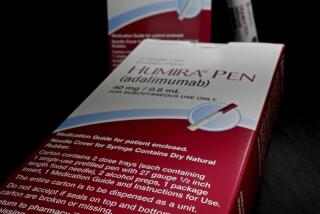Merger to Create New Biotech Giant
- Share via
Johnson & Johnson, one of the world’s biggest health products companies, will become one of the largest biotech companies with its acquisition of Centocor in a $4.9-billion stock swap announced Wednesday.
Johnson & Johnson officials say that the long-rumored deal offers new opportunities for the company to expand its pharmaceutical sales in cardiology and rheumatoid arthritis.
Centocor, one of the first biotech companies and one of the few that are profitable, has only a minimal sales force of its own and expects to gain sales from its merger with the pharmaceutical giant.
Centocor shareholders would receive the equivalent of $61 a share--an amount that could drop as low as $52 if Johnson & Johnson shares should plummet.
The deal, which must be approved by Centocor shareholders, comes at a time when large drug manufacturing companies are eagerly seeking new products to boost sales and sustain growth. The deal is one of several mergers over the last year between big pharmaceutical companies and late-stage biotech firms with products on the market.
For drug companies that are enjoying high share prices, this is a particularly opportune time to snatch up smaller firms with strong product pipelines.
“What’s happened is that the pharmaceutical industry needs more products and it is cheaper to buy a company than license the product,” said Jim McCamant, editor of Medical Technology Stock Letter.
Centocor, founded in 1979 and based in Malvern, Pa., is one of several companies built on monoclonal antibody technology--the ability to manufacture large quantities of antibodies to block specific cells or natural substances.
“When the monoclonals first came out, they were looked at as silver bullets for treating cancer,” said Centocor spokesman Christopher Allman. The early attempts proved disappointing.
But today, the company has several drugs on the market, including ReoPro, its best-selling product, which helps prevent blood clots and other complications during medical procedures to improve blood flow to the heart. And it has Remicade, a treatment for Crohn’s disease, a debilitating intestinal disorder.
The company, which had revenue of $338 million in its last fiscal year, has marketing agreements for ReoPro with Eli Lilly & Co. and for Remicade with Schering-Plough Corp. But Johnson & Johnson would be able to market those drugs for other medical conditions, according to Allman. ReoPro, for example, is now under review for use following heart attacks, and Remicade is in the final phases of testing for moderate-to-severe rheumatoid arthritis.
Since the biotechnology industry began in the 1970s, bigger pharmaceutical and biotech companies have been periodically gobbling up smaller ones. Recently, there seems to be a resurgence of mergers and acquisitions in the industry.
In January, Warner-Lambert Co. announced it was purchasing San Diego-based Agouron Pharmaceuticals for $2.1 billion, and last month, Abbott Laboratories acquired Alza Corp. in Palo Alto.
The pattern is cyclical, says Karen Bernstein, editor of BioCentury, a trade newsletter.
The companies that are being acquired, she said, are the more mature firms with products on the market and expectations from their shareholders. The only way for them to keep earnings up and continue developing new products is to join forces with “companies that have more muscle.”
And several of the larger biotech and pharmaceutical companies have healthy cash balances or surging share values that allow them to shop for smaller companies.
The largest of the biotech firms, Amgen Inc. in Thousand Oaks, has more than $1 billion in cash to acquire new products and companies. It’s chairman, Gordon Binder, says he wants to keep the company independent, but has an eye out for a good acquisition.
Centocor shares closed at $57.38, up 16%, on Nasdaq; Johnson & Johnson closed at $97.44, up 1%, on the New York Stock Exchange.
* BIOTECH RALLY: Key index nears the all-time high set in ’92. C11
More to Read
Sign up for Essential California
The most important California stories and recommendations in your inbox every morning.
You may occasionally receive promotional content from the Los Angeles Times.













